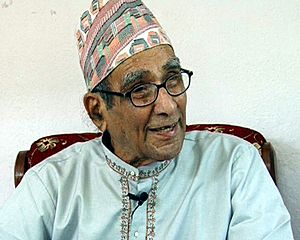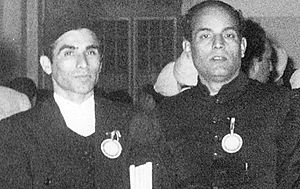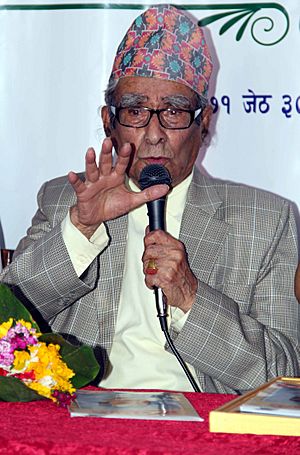Madhav Prasad Ghimire facts for kids
Quick facts for kids
Rashtrakavi (National Poet)
Madhav Prasad Ghimire
|
|
|---|---|
 |
|
| Native name |
माधव प्रसाद घिमिरे
|
| Born | 23 September 1919 Lamjung, Nepal |
| Died | 18 August 2020 (aged 100) Kathmandu, Nepal |
| Occupation |
|
| Language | Nepali |
| Genre |
|
| Subject |
|
| Years active | 1934–2020 |
| Notable works | Malati Mangale, Shakuntala, Himalwaari Himalpaari, Gauri |
| Notable awards | Gorkha Dakshinbahu Tribhuwan Pragya Puraskar Sajha Puraskar |
| Spouse |
Gauri Ghimire (née Pokharel) (1933–34 to 1947–48), Mahakali Ghimire (1948–2020; his death)
|
| Children | 8 |
Madhav Prasad Ghimire (माधव प्रसाद घिमिरे; born 23 September 1919 – died 18 August 2020) was a famous Nepali poet and scholar. He was given the special title of Rashtrakavi, which means National Poet, by the Government of Nepal in 2003. Some of his most well-known works include Gauri, Malati Mangale, Shakuntala, and Himalwari Himalpari.
Born in Lamjung, Nepal, Madhav Prasad Ghimire studied in Kathmandu and Banaras, India. He had a very long career in literature, lasting 86 years! During this time, he wrote many epic poems, plays, and essays. He also wrote popular songs like "Gaucha Geet Nepali" and "Nepali Hami Rahaula Kaha". He helped edit and write for literary magazines and newspapers. He served as the Vice Chancellor of the Royal Nepal Academy for 10 years and later as its Chancellor for two more years. He was working on a new epic poem called Ritambhara when he passed away at the age of 100 in August 2020. He received many awards, including the Order of Gorkha Dakshina Bahu and the Sajha Puraskar.
Contents
Early Life and Education
Madhav Prasad Ghimire was born on 23 September 1919, in a village called Bhirpustung in the Lamjung district of Nepal. Sadly, his mother passed away when he was only three years old. His father, Gauri Shankar Ghimire, and his grandmother raised him.
He started learning to read when he was six. By the age of eight or nine, he learned about the Panchanga, which is a traditional Hindu calendar, from a person known as Fulebaba. When he was 11, he left home to study Sanskrit in Duredada village. Later, he moved to Kathmandu to continue his Sanskrit studies. He also traveled to India to study further in Banaras.
A Career in Writing
Madhav Prasad Ghimire's writing journey began in his childhood, while he was living in the hills of Lamjung District. His very first published work was called Gyanpuspa, and it appeared in the newspaper Gorkhapatra when he was just 14 years old.
After returning from Varanasi, he worked as a writer for Bhashanubad Parishad. Later, in 1944, he became a co-editor for Gorkhapatra, and by 1946, he was the editor. He also wrote for other important journals like Sharada and Udaya. Many believe that Ghimire was greatly inspired by the famous Indian poet Rabindranath Tagore.

In 1951, he went back to his home village and worked as a teacher for a short time. In 1953, he joined Kavya Pratisthan, a literary group led by another great Nepali poet, Laxmi Prasad Devkota.
One of his most popular works, Gauri, was written in 1947. He wrote this sad epic poem to remember his first wife, who had passed away.
Famous Works and Style
Some of Madhav Prasad Ghimire's well-known works include:
- Gauri (an epic poem)
- Malati Mangale
- Manjari
- Indrakumari
- Rastra Nirmata
- Kinnar-Kinnari (a collection of lyrical poems)
- Charu Charcha (a collection of essays)
- Aafno Bansuri Aafnai Geet
- Himal Pari Himal Wari
- Aswathama
- Rajheswari
- Shakuntala (an epic poem)
He also wrote many popular songs that people still love today, such as "Gauncha Geet Nepali", "Nepali Hami Rahaula Kaha", "Baisakh", "Phoolko Thunga Bagera Gayo", and "Aajai Rati Dekhe Sapana".
Ghimire's poems often followed a style called chanda poetry. This style combines rhythm with a fixed meter, making the poems flow beautifully. He was known for blending classic Sanskrit ideas with romantic themes. His poems often talked about patriotism and the beauty of nature. Since he grew up in the hills, mountains and the Himalayas often appeared in his works. He was also a follower of the poetic style of Laxmi Prasad Devkota.
From 1979 to 1988, Ghimire was the Vice Chancellor of the Royal Nepal Academy. He then became the Chancellor of the same academy from 1988 to 1990. He was working on another epic poem, Ritambhara, when he passed away.
Later Life
Madhav Prasad Ghimire's 100th birthday was a big celebration across Nepal on 23 September 2018. Many events were held to honor him.
He passed away on 18 August 2020, at the age of 100, at his home in Kathmandu due to health issues. His body was cremated with state honors at Pashupati Aryaghat. Ghimire was also an honorary Brigadier General in the Nepali Army.
Personal Life
Madhav Prasad Ghimire had eight children in total: six daughters and two sons from two marriages. His first wife, Gauri, passed away after fourteen years of marriage. They had two daughters together. He wrote Gauri, a famous and moving epic poem, in her memory. Later, he married his second wife, Mahakali. They had two sons and four daughters.
Awards and Honours
Madhav Prasad Ghimire received many awards and honors for his contributions to Nepali literature. Some of them include:
- Distinguished Academy Medal
- Shree Prasiddha Praval Gorkha Dakshinabahu
- Bhanubhakta Award
- Tribhuwan Pragya Puraskar
- Padmashree Sadhana Samman Puraskar
- Sajha Award
Images for kids
-
Madhav Prasad Ghimire with Laxmi Prasad Devkota in 1946
See also
 In Spanish: Madhav Prasad Ghimire para niños
In Spanish: Madhav Prasad Ghimire para niños




